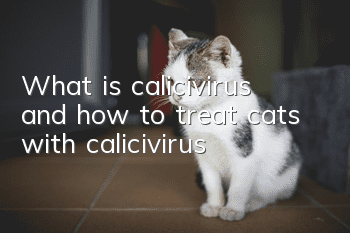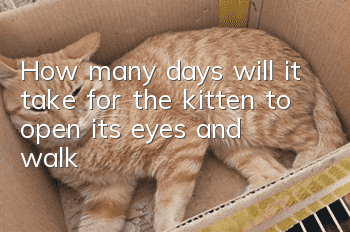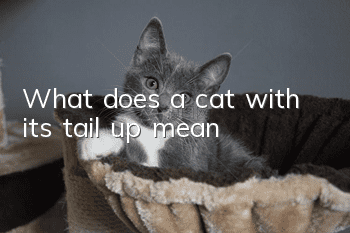What is calicivirus and how to treat cats with calicivirus

Feline calicivirus is also called FCV. In fact, calicivirus infection is a common respiratory disease in cats. The most common symptom is sneezing. It may also be accompanied by symptoms such as drooling, unsteady walking, prolonged sleep time, and poor mental health. , mainly affecting the cat’s respiratory tract (nasal cavity and lungs), oral cavity (tongue ulcers), intestinal tract and musculoskeletal system.
Feline cupping is highly contagious among young cats, especially cats that have not been vaccinated, multi-cat households or cats live in an environment with poor ventilation, so you need to pay attention! Once you find a cat sneezing frequently, you should promptly Take him to the hospital for examination. There are at least 40 different FCV strains of calicivirus, which may cause different severities due to different strains!
How is Calicivirus spread?
· Transmitted through the air
When a cat sneezes, the virus can spread through the air through droplets. Although most of the droplets fall to the ground, the virus can survive on smiling dust particles or dander and remain there for several hours until it is picked up by another person. If inhaled by a host, it can cause serious damage to the respiratory tract.
· Contact with contaminated objects
This type of disease often occurs in households with multiple cats. When they share water or food bowls, they are easily infected with the virus. Therefore, maintaining good hygiene habits is very important for the health of cats. Failure to clean the food bowl or replace fresh cat food in time can also cause cats to suffer from such diseases.
· Contact with infected cats
When a healthy cat comes into contact with the saliva, eyes, nasal mucus, or feces of an infected cat, it can easily become infected! Especially in foster care, be sure to confirm whether the place where the sample is sent has good Preventive and isolation measures should be taken to protect cats from being affected by calicivirus.
What are the symptoms of calicivirus infection?
· Nasal discharge (transparent color may develop into purulent color)
· sneezing
· Loss of appetite and dehydration
· Lack of energy and lethargy
· Difficulty chewing food and drooling
· Red eyes (caused by secondary conjunctivitis)
· Oral ulcer
· Breathing sounds become louder, noisy, and difficult
· Fever (ears and pads are hot)
· Acute upper respiratory tract infection
· Gingivitis, stomatitis
·Joint pain
· Pneumonia, hepatitis, pancreatitis (caused by very few viral mutations)
But many symptoms do not directly indicate whether a cat is infected with calicivirus, because it can manifest in many different forms, each of which may be caused by other pathogens. Like mouth ulcers, feline herpes virus can also cause this phenomenon, although it is less common than calicivirus.
Why can FCV be detected even after vaccination?
FCV vaccinations are important for cats, but they do not necessarily prevent FCV infection, they can only reduce the severity of the disease. Vaccination can only control viral infections but cannot be used as the only tool to prevent the disease.
And some studies show that the protective effects of vaccines against respiratory viruses diminish over time. Therefore, when the risk of infection is high, a catch-up shot can be given to enhance the immune effect of the vaccine.
How to treat calicivirus?
There is no complete cure for calicivirus. It is often complicated by secondary bacterial infection. Many people will recommend supportive treatment with antibiotics, but antibiotics are of viral origin and are only useful when there is a secondary bacterial infection. , does not work against viruses, and may cause cats to become anorexic, which will worsen the situation. Therefore, good nursing care is very important, which can effectively help them reduce the severity of clinical symptoms.
· Gently wipe their body with a damp towel without touching their eyes and nose.
· Take your cat into the bathroom (not a shower), the hot steam can help provide moisture to their noses.
· Minimize stress when your cat is sick and keep away from other cats to prevent spreading the virus.
· Because cats cannot smell food very clearly, try to eat heated food.
· Repeatedly disinfect the food bowl, cat litter box, water bowl, etc. used by it.
· You should wash your hands thoroughly before and after contact with other cats to reduce the risk of disease transmission.
How to proactively prevent feline calicivirus infection?
· Disinfect air
Calicivirus in cats is spread through the air because the pathogen can survive for a long time on dust particles and dander, so we can use an air purification system to eliminate bacteria and viruses floating in the air. In addition, you can also ventilate regularly to maintain good air quality in your home.
· Disinfection items
Regularly clean and disinfect your cat’s water bowl, food bowl, cat litter and other items. If you have multiple cats in your home, they need to be kept in isolation.
· Avoid new members
If an indigenous person has been infected with calicivirus, adding a new cat will increase the chance of the disease relapsing. The new member may cause strong stress, reduce the resistance of the indigenous person, and make it more susceptible to infection. Viral infection.
- Is neutering a female cat dangerous? Things to pay attention to and care methods for neutering female cats!
- What foods should cats not touch? You need to know the dietary taboos for cats!
- Can cats be walked? Choose the right equipment and your cat can still be walked!
- How to judge whether a Ragdoll cat is pure or not?
- Why do cats always sleep?
- What is the difference between pure and impure Ragdoll cats? Ragdoll cat breeds!
- What to do if a cat gets ringworm? How to treat ringworm in kittens
- Is there any way to prevent Ragdoll cats from losing hair? Teach you the solution!
- Why are cats afraid of orange peels?
- What does it mean when a cat licks a person's face and hands?



